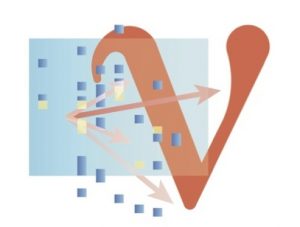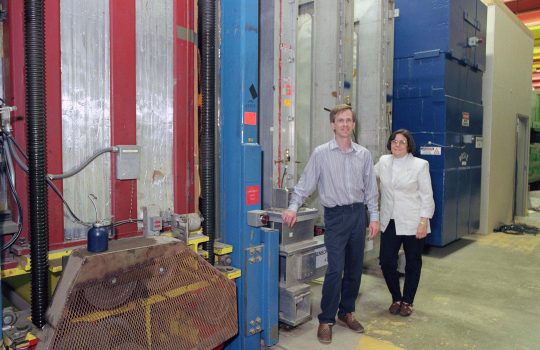The 27th International Conference on Neutrino Physics and Astrophysics, commonly called Neutrino 2016, will be hosted by the Institute of Physics and Imperial College London at the Royal Geographical Society in South Kensington. The conference will bring together physicists from around the world to discuss the latest theories and findings in neutrino physics and astrophysics.
Scientists working with the U.S. Department of Energy’s Fermi National Accelerator Laboratory will give numerous presentations at Neutrino 2016 and unveil some significant results. Here is a quick guide to the Fermilab experiments represented at the conference and what new developments to expect. (If you’re not attending Neutrino 2016, don’t worry. You can keep up with all these results by following Fermilab on Twitter @Fermilab.)
Times are in British Summer Time.
- New results from NOvA – July 4, 11:30 a.m.
Nearly a year ago, the NOvA experiment – Fermilab’s flagship neutrino experiment – presented its first oscillation results. The two NOvA detectors sit more than 800 kilometers apart, in the path of Fermilab’s intense neutrino beam, and are designed to catch muon neutrinos changing into electron neutrinos on their journey from Fermilab in Illinois to northern Minnesota.
At Neutrino 2016, the NOvA collaboration will present its next set of oscillation results, working with more than twice the amount of data they had a year ago. They will also offer their first result on the search for sterile neutrinos (a theorized fourth type of neutrino that does not interact with matter in the same way as the three types scientists have observed), and present improvements to their analyses of muon neutrino disappearance and electron neutrino appearance events. Patricia Vahle of the College of William and Mary will give this talk.
“We are delighted to be showing our results on the first day of the conference, and we look forward to seeing what everyone else has to say,” said Peter Shanahan of Fermilab, co-spokesperson of the NOvA experiment.
- A strong farewell from MINOS+ – July 5, 2 p.m.
The MINOS experiment was Fermilab’s first foray into long-distance neutrino oscillation physics and has been running for 13 years (the last three as MINOS+, with a higher-energy neutrino beam). With the MINOS far detector set to cease operation this summer, the collaboration plans to go out with a bang at Neutrino 2016.
The MINOS+ talk, presented by Justin Evans of the University of Manchester, will include a joint result with the Daya Bay experiment in China on the search for sterile neutrinos. The collaboration will also present results on nonstandard neutrino interactions and large extra dimensions, an area also probed by the Large Hadron Collider, as well as updating its standard oscillation results using all MINOS data and the first two years of MINOS+ data.
“We’re very pleased that even after more than 10 years, we still have exciting results coming out,” Evans said.
- First results from MicroBooNE – July 5, 12:05 p.m.
Tuesday’s talk, presented by Matthew Toups of Fermilab, will be MicroBooNE’s public debut. The short-baseline experiment started taking data in 2015, using liquid argon to record precise tracks of neutrino interactions in order to search for sterile neutrinos. For the first time, the physics community will get a good look at the initial data collected since the start of the experiment. The collaboration will showcase the detector and the software that creates beautiful 3-D images of neutrino interactions and provide a taste of the first of those interactions they captured. The technology behind MicroBooNE will be scaled up and used for future neutrino projects, including the Deep Underground Neutrino Experiment (DUNE), Fermilab’s proposed new flagship. (More on that experiment below.)
- New cross section measurements from MINERvA – July 5, 11:40 a.m.
The MINERvA detector, located 350 feet underground at Fermilab, is measuring how neutrinos interact with nuclei with unprecedented precision. Using target materials ranging from helium all the way to lead, MINERvA is producing results that are used by neutrino oscillation experiments worldwide such as Fermilab’s NOvA, T2K in Japan and the planned international DUNE experiment. Since the last Neutrino conference, MINERvA has published nine papers on a wide variety of neutrino and antineutrino processes and is still uncovering new surprises about the way neutrinos interact in nuclei. Laura Fields of Fermilab will present highlights from these MINERvA results and explain how they help to ensure the most precise measurements of the properties of neutrinos.
- The short-baseline neutrino program at Fermilab – July 5, 3:10 p.m.
In early 2017, scientists will transport the largest liquid-argon neutrino detector ever built, called ICARUS, from CERN to Fermilab. It will then take its place as one of three detectors in a new experimental program at Fermilab that will search for the long-theorized sterile neutrino. MicroBooNE (mentioned above) is already hunting for these particles, while scientists are currently building a third detector, the Short-Baseline Near Detector, to round out the suite. David Schmitz of the University of Chicago, co-spokesperson of the SBND experiment, will outline all the details of this new program.
- DUNE: Status and prospects – July 6, 9:20 a.m.
More than 850 scientists from 30 countries around the world are building prototype detectors and advancing plans for the Deep Underground Neutrino Experiment. DUNE will make use of Fermilab’s accelerator complex and send the world’s most intense neutrino beam 1,300 kilometers to the Sanford Underground Research Facility in South Dakota, where the largest liquid-argon neutrino detector ever built will be constructed. Jon Urheim of Indiana University will discuss this long-term, visionary project.
While these are the most prominent Fermilab-related talks at Neutrino 2016, they aren’t the only ones. Fermilab scientists will discuss high-intensity neutrino beams on July 9, and many Fermilab experiments will be represented at poster sessions. For more information about Fermilab’s neutrino program, please visit the laboratory website at www.fnal.gov. And don’t forget to follow Fermilab on Twitter (@Fermilab) for the latest news out of Neutrino 2016.
Fermilab is America’s premier national laboratory for particle physics research. A U.S. Department of Energy Office of Science laboratory, Fermilab is located near Chicago, Illinois, and is operated under contract by the Fermi Research Alliance LLC. Visit Fermilab’s website at www.fnal.gov, and follow Fermilab on Facebook at www.facebook.com/fermilab and on Twitter @Fermilab.
The DOE Office of Science is the single largest supporter of basic research in the physical sciences in the United States, and is working to address some of the most pressing challenges of our time. For more information, please visit science.energy.gov.




